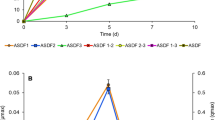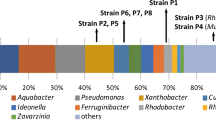Abstract
Aromatic volatile organic compounds (VOCs) are a type of common pollution form in chemical contaminated sites. In this study, seven aromatic VOCs such as benzene, toluene, ethylbenzene, chlorobenzene, m-xylene, p-chlorotoluene and p-chlorotrifluorotoluene were used as the only carbon source, and four strains of highly efficient degrading bacteria were screened from the soil of chemical contaminated sites, then the synthetic bacterial consortium was constructed after mixing with an existing functional strain (Bacillus benzoevorans) preserved in the laboratory. After that, the synthetic bacterial consortium was used to explore the degradation effect of simulated aromatic VOCs polluted wastewater. The results showed that the functional bacterium could metabolize with aromatic VOCs as the only carbon source and energy. Meanwhile, the growth of the synthetic bacterial consortium increased with the additional carbon resources and the alternative of organic nitrogen source. Ultimately, the applicability of the synthetic bacterial consortium in organic contaminated sites was explored through the study of broad-spectrum activity.
Graphical Abstract

Highlights
A high-efficient synthetic bacterial consortium was constructed to degrade aromatic VOCs.
Additional carbon and alternative of organic nitrogen can effectively promote the degradation.
Degradation rate of total aromatic VOCs gained over 75% by the synthetic bacterial consortium.






Similar content being viewed by others
Data availability
The datasets used and/or analyzed during the current study are available from the corresponding author on reasonable request.
References
Mukherjee S, Sensharma D, Qazvini OT, Dutta S, Macreadie LK, Ghosh SK, Babarao R (2021) Advances in adsorptive separation of benzene and cyclohexane by metal-organic framework adsorbents. Coord Chem Rev 437:1–25
Joksimoski S, Kerpen K, Telgheder U (2022) Atmospheric pressure photoionization—high-field asymmetric ion mobility spectrometry (APPI-FAIMS) studies for on-site monitoring of aromatic volatile organic compounds (VOCs) in groundwater. Talanta 247:123555
Xie X, Cao J, Xiang Y, Xie R, Suo Z, Ao Z, Yang X, Huang H (2022) Accelerated iron cycle inducing molecular oxygen activation for deep oxidation of aromatic VOCs in MoS2 co-catalytic Fe3+/PMS system. Appl Catal B 309:121535
Yang Y, Lin B, Sun C, Tang M, Lu S, Huang Q, Yan J (2021) Facile synthesis of tailored mesopore-enriched hierarchical porous carbon from food waste for rapid removal of aromatic VOCs. Sci Total Environ 773:145453
Wantz E, Kane A, Lhuissier M, Amrane A, Audic J-L, Couvert A (2021) A mathematical model for VOCs removal in a treatment process coupling absorption and biodegradation. Chem Eng J 423:130106
Ma Y, Fu S, Gao S, Zhang S, Che X, Wang Q, Jiao Z (2021) Update on volatile organic compound (VOC) source profiles and ozone formation potential in synthetic resins industry in China. Environ Pollut 291:118253
Ramu AG, Muthuraman G, Moon IS (2020) Consistent room temperature electrochemical reduction of gaseous chlorobenzene to value-added intermediates by electroscrubbing. J Ind Eng Chem 89:334–338
Wei L, Yu C, Yang K, Fan Q, Ji H (2021) Recent advances in VOCs and CO removal via photothermal synergistic catalysis. Chin J Catal 42:1078–1095
Liu N, Li D, Li K, Wang L, Xu R, Zhang J, Yang B (2021) Enhanced biodegradation of chlorobenzene via combined Fe(3+) and Zn(2+) based on rhamnolipid solubilisation. J Environ Sci (China) 103:108–118
Lee EH, Ryu HW, Cho KS (2009) Removal of benzene and toluene in polyurethane biofilter immobilized with Rhodococcus sp. EH831 under transient loading. Bioresour Technol 100:5656–5663
Lee EH, Cho KS (2009) Effect of substrate interaction on the degradation of methyl tert-butyl ether, benzene, toluene, ethylbenzene, and xylene by Rhodococcus sp. J Hazard Mater 167:669–674
Guo H, Yao J, Chen H, Wang J, Masakorala K, Jin Y, Richnow HH, Blake RE (2012) Substrate interactions during biodegradation of benzene/alkylbenzene mixtures by Rhodococcus sp. ustb-1. Int Biodeterior Biodegradation 75:124–130
Di Martino C, López NI, Raiger Iustman LJ (2012) Isolation and characterization of benzene, toluene and xylene degrading Pseudomonas sp. selected as candidates for bioremediation. Int Biodeterior Biodegradation 67:15–20
Feng S, Gong L, Zhang Y, Tong Y, Zhang H, Zhu D, Huang X, Yang H (2021) Bioaugmentation potential evaluation of a bacterial consortium composed of isolated Pseudomonas and Rhodococcus for degrading benzene, toluene and styrene in sludge and sewage. Bioresour Technol 320:124329
Kureel MK, Geed SR, Giri BS, Rai BN, Singh RS (2017) Biodegradation and kinetic study of benzene in bioreactor packed with PUF and alginate beads and immobilized with Bacillus sp. M3. Bioresour Technol 242:92–100
Zhang L, Zhang C, Cheng Z, Yao Y, Chen J (2013) Biodegradation of benzene, toluene, ethylbenzene, and o-xylene by the bacterium Mycobacterium cosmeticum byf-4. Chemosphere 90:1340–1347
Yu J, Liu Q, Hu J, Feng Z (2017) Degradation of o-xylene by a novel strain, Zoogloearesiniphila HJ1: Identification, kinetics and metabolic pathway. Global NEST J 19:241–250
Cho E, Galera MM, Lorenzana A, Chung WJ (2009) Ethylbenzene, o Xylene, and BTEX removal by Sphingomonas sp. D3K1 in rock wool-compost biofilters. Environ Eng Sci 26:45–52
Guo Y, Dong S, Zhou D (2022) Optimization of the photocatalyst coating and operating conditions in an intimately coupled photocatalysis and biodegradation reactor: towards stable and efficient performance. Environ Res 204:111971
Chen J (2010) The research of trace metal elements in raising production of biogas. Shandong Institute of Light Industry, China
Cai Y, Yan Z, Ou Y, Peng B, Zhang L, Shao J, Lin Y, Zhang J (2022) Effects of different carbon sources on the removal of ciprofloxacin and pollutants by activated sludge: mechanism and biodegradation. J Environ Sci (China) 111:240–248
Mahmoud A, Hamza RA, Elbeshbishy E (2022) Enhancement of denitrification efficiency using municipal and industrial waste fermentation liquids as external carbon sources. Sci Total Environ 816:151578
Fu X, Hou R, Yang P, Qian S, Feng Z, Chen Z, Wang F, Yuan R, Chen H, Zhou B (2022) Application of external carbon source in heterotrophic denitrification of domestic sewage: a review. Sci Total Environ 817:153061
Zhou J, Shen R (2013) Great dictionary of soil science. Science Press 123–126
Iwanicki NSA, Mascarin GM, Moreno SG, Eilenberg J, Delalibera Junior I (2020) Growth kinetic and nitrogen source optimization for liquid culture fermentation of Metarhizium robertsii blastospores and bioefficacy against the corn leafhopper Dalbulus maidis. World J Microbiol Biotechnol 36:71
Liang DH, Hu Y (2019) Simultaneous sulfamethoxazole biodegradation and nitrogen conversion by Achromobacter sp. JL9 using with different carbon and nitrogen sources. Bioresour Technol 293:122061
Du L, Hao Y, Chen N, Xu Q (2019) Organic nitrogen source and their applications in microbial fermentation. Bull Ferment Sci Technol 48:1–4
Zhong C, Jian SF, Chen DL, Huang XJ, Miao JH (2021) Organic nitrogen sources promote andrographolide biosynthesis by reducing nitrogen metabolism and increasing carbon accumulation in Andrographis paniculata. Plant Physiol Biochem 164:82–91
Chen Z (2019) Isolation of silicate activating bacteria and its activation of effective silicon in electrolytic manganese slag. South-Central University for Nationalities, Wuhan
Wang Y, Nie M, Diwu Z, Chang F, Nie H, Zhang B, Bai X, Yin Q (2021) Toxicity evaluation of the metabolites derived from the degradation of phenanthrene by one of a soil ubiquitous PAHs-degrading strain Rhodococcus qingshengii FF. J Hazard Mater 415:125657
Rodríguez-Uribe ML, Peña-Cabriales JJ, Rivera-Cruz MdC, Délano-Frier JP (2021) Native bacteria isolated from weathered petroleum oil-contaminated soils in Tabasco, Mexico, accelerate the degradation petroleum hydrocarbons in saline soil microcosms. Environ Technol Innov 23:101781
Nie H, Nie M, Diwu Z, Wang L, Yan H, Bai X (2021) Immobilization of Rhodococcus qingshengii strain FF on the surface of polyethylene and its adsorption and biodegradation of mimic produced water. J Hazard Mater 403:124075
Song B, Tang J, Zhen M, Liu X (2019) Influence of graphene oxide and biochar on anaerobic degradation of petroleum hydrocarbons. J Biosci Bioeng 128:72–79
Li X, Peng D, Zhang Y, Ju D, Guan C (2021) Achromobacter sp. PHED2 enhances the phenanthrene degradation and stress tolerance in maize involving the participation of salicylic acid. Environ Technol Innov 21:101365
Mohapatra B, Kazy SK, Sar P (2019) Comparative genome analysis of arsenic reducing, hydrocarbon metabolizing groundwater bacterium Achromobacter sp. KAs 3–5(T) explains its competitive edge for survival in aquifer environment. Genomics 111:1604–1619
Huang XN, Min D, Liu DF, Cheng L, Qian C, Li WW, Yu HQ (2019) Formation mechanism of organo-chromium (III) complexes from bioreduction of chromium (VI) by Aeromonas hydrophila. Environ Int 129:86–94
Zhang Y, Tang Y, Qin Z, Luo P, Ma Z, Tan M, Kang H, Huang Z (2019) A novel manganese oxidizing bacterium-Aeromonas hydrophila strain DS02: Mn(II) oxidization and biogenic Mn oxides generation. J Hazard Mater 367:539–545
Subari F, Kamaruzzaman MA, Sheikh Abdullah SR, Hasan HA, Othman AR (2018) Simultaneous removal of ammonium and manganese in slow sand biofilter (SSB) by naturally grown bacteria from lake water and its diverse microbial community. J Environ Chem Eng 6:6351–6358
Wen G (2009) Isolation of chlorobenzene-degrading strain and its degradation conditions. Amino Acids Biotic Resour 31:1–8
Reardon KF, Mosteller DC, Rogers JDB (2015) Biodegradation kinetics of benzene, toluene, and phenol as single and mixed substrates for Pseudomonas putida F1. Biotechnol Bioeng 69:385–400
Nagarajan K, Loh KC (2015) Formulation of microbial cocktails for BTEX biodegradation. Biodegradation 26:51–63
Tavakoli A, Hamzah A, Rabu A (2016) Expression, purification and kinetic characterization of recombinant benzoate dioxygenase from Rhodococcus ruber UKMP-5M. Mol Biol Res Commun 5:133–142
Zhang Y, Feng S, Yang H, Huang X, Tang J, Wu Q, Gu L (2017) Isolation and characterization of benzene degradation strain Pseudomonas putida SW-3. J Microbiol 44:2096–2103
Qin J, Wang S, Zhu X, Zhang Y (2018) The study on the selection of bacterial strain degrading benzene in polluted undergroud water. Min Eng 16:70–73
Tsipa A, Koutinas M, Vernardis SI, Mantalaris A (2017) The impact of succinate trace on pWW0 and ortho-cleavage pathway transcription in Pseudomonas putida mt-2 during toluene biodegradation. Bioresour Technol 234:397–405
Acknowledgements
This project was financially supported by the National Natural Science Foundation of China (grant number 51974279), the National Key Research & Development Program of China [grant numbers 2018YFC18018, 2018YFC18027], KeJunPing [2018] No. 159, the Guangxi Scientific Research and Technology Development Plan [grants numbers GuikeAB16380287, GuikeAB17129025], GRINM Science and Development [grants number 2020 No 75], which are greatly appreciated.
Funding
National Natural Science Foundation of China, 51974279
Author information
Authors and Affiliations
Corresponding author
Ethics declarations
Conflict of interest
The authors declare that they have no conflict of interest.
Additional information
Publisher's Note
Springer Nature remains neutral with regard to jurisdictional claims in published maps and institutional affiliations.
Supplementary Information
Below is the link to the electronic supplementary material.
Rights and permissions
Springer Nature or its licensor (e.g. a society or other partner) holds exclusive rights to this article under a publishing agreement with the author(s) or other rightsholder(s); author self-archiving of the accepted manuscript version of this article is solely governed by the terms of such publishing agreement and applicable law.
About this article
Cite this article
Lv, Y., Wang, L., Liu, X. et al. Construction and function of a high-efficient synthetic bacterial consortium to degrade aromatic VOCs. Bioprocess Biosyst Eng 46, 851–865 (2023). https://doi.org/10.1007/s00449-023-02869-2
Received:
Accepted:
Published:
Issue Date:
DOI: https://doi.org/10.1007/s00449-023-02869-2




